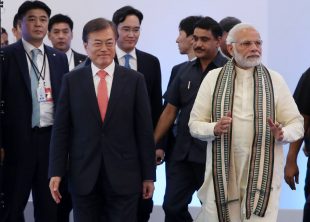A Relationship Committed To Success
India and South Korea share one dream, that of economic success and peace
From dispatching a batch of medics in 1950-53 during the inter-Korean war, to maintaining diplomatic relations with both the north and the south during the cold war, ever since its independence, India has chosen to maintain a civil relationship with the Korean Peninsula. It was only after South Korea established itself as a democracy in 1987 and India initiated its Look (now Act) East Policy (AEP) and economic reforms in the 90s, did the economic relationship between the two countries really begin to strengthen.
When South Korea launched its New Southern Policy (NSP) in November last year, it began a new era for India and South Korea relations. The NSP, very similar to the Indian AEP accords priority to relations with the Association of South East Asian Nations and India (before the NSP, South Korea was more focused on DPRK and the K4). The NSP was the work of President Moon Jae In, who has been pulling off one remarkable feat after another, ever since he assumed office last year. In a first, he also sent a special envoy to India last June to meet PM Modi.
As he makes his maiden visit to India this week, it is on the heels of the 45th anniversary of bi-lateral ties with the Peninsula. Soon after his arrival, President Moon visited the Akshardham Temple, rode the Delhi Metro with Prime Minister Modi and inaugurated the largest Samsung manufacturing unit in the country (35 acres). At the time of the inauguration, PM Modi said that, “Whenever I talk to business community representatives I always mention one thing – that I don’t think there is a middle class home in India where a Korean product is not found.”
On Monday, President Moon also met the Minister of External Affairs, Sushma Swaraj. Today, he will be accorded ceremonial reception at the Rashtrapati Bhavan .He is also expected to meet with PM Modi and hold bilateral talks as well as likely to revise and sign an updated Comprehensive Economic Partnership Agreement (CEPA). There is also talk of forming a Korea-India Future Vision Strategy Group, which will identify research projects and exchange programmes on biotech, energy, health care, software and cyber security. A memorial park for Korean Queen He Hwang-ok in Ayodhya, UP, has been proposed and it is likely to come up in conversation.
According to the 13th century SamgukYusa or The Heritage History of the Three Kingdoms, a princess from Ayodhya (Suriratna) travelled to Korea, married King Kim-Suro and subsequently became Queen Hur Hwang-ok in 48 AD. There have been previous Korean leaders who claim to trace their ancestry to this unlikely royal couple, these include—former President Kim Dae-jung, former President Kim Young-sam and former PM Kim Jong-pil.
Before President Moon departs he will also be hosted by the President of India Ram Nath Kovind, who will host a state banquet at the Rashtrapati Bhavan in his honour.
The relationship between India and South Korea is largely issue-less despite the close ties between Beijing and Seoul. So far, President Moon has enjoyed a pleasant and rather warm reception, both from the officials as well as the media that has enthusiastically reported on the strengthening economic policy between India and South Korea, the role of President Moon in negotiating peace in the Korean Peninsula, the role India can play in that partnership. South Korea is a very valued economic partner for India and bi-lateral trade is one of the most important subjects that this visit is going to touch upon. Since there are already over 700 Korean companies present in India at the moment and Indian exports to the country accounted for $2.91 billion and imports accounted for $8.707 billion during January-July 2017, marking a growth of 26 per cent and 30.1 per cent, respectively, President Moon’s visit comes as a reaffirmation to the commitment of strengthening trade between the two countries.
By Gunjeet Sra, editor-in-chief of Sbcltr Media



























































